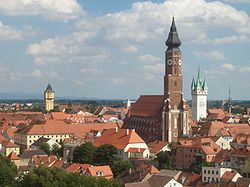Straubing
| Straubing | ||
|---|---|---|

View of Straubing.
|
||
|
||
| Coordinates: 48°53′N 12°34′E / 48.883°N 12.567°ECoordinates: 48°53′N 12°34′E / 48.883°N 12.567°E | ||
| Country | Germany | |
| State | Bavaria | |
| Admin. region | Niederbayern | |
| District | Urban district | |
| Government | ||
| • Mayor | Markus Pannermayr (CSU) | |
| Area | ||
| • Total | 67.58 km2 (26.09 sq mi) | |
| Population (2015-12-31) | ||
| • Total | 46,806 | |
| • Density | 690/km2 (1,800/sq mi) | |
| Time zone | CET/CEST (UTC+1/+2) | |
| Postal codes | 94301–94315 | |
| Dialling codes | 09421 | |
| Vehicle registration | SR | |
| Website | www.straubing.de | |
Straubing is an independent city in Lower Bavaria, southern Germany. It is seat of the district of Straubing-Bogen. Annually in August the Gäubodenvolksfest, the second largest fair in Bavaria, is held.
The city is located on the Danube forming the centre of the Gäuboden.
The area of Straubing has been continuously settled since the Neolithic. The conquest by the Romans in 16–14 BC had a dramatic impact on the whole region. Even today many traces of the 400-year Roman occupation can be found: for example, the famous 'Römerschatz' (Roman treasure) which is shown in the Gäubodenmuseum. Sorviodurum, as the Romans called it, was an important military support base.
After the fall of the Roman Empire Straubing became a centre of settlement of the Bavarii, mostly around St. Peter's Church (built in the 9th century) between Allachbach and Danube. According to the customs of the Bavarii the settlement was named after their leader Strupinga, which later evolved into the name Straubing.
In 1218 a new part of the city (called 'new town') was founded by Duke Ludwig I Wittelsbach of Bavaria. Straubing became the capital of the Duchy of Bavaria-Straubing under Duke Wilhelm I when Bavaria was divided among the sons of Louis IV, Holy Roman Emperor in 1349. In 1429 Straubing passed to Ernest, Duke of Bavaria-Munich, who ordered the murder of Agnes Bernauer in Straubing. The grave of Agnes Bernauer cannot be found. But in the graveyard of St. Peter's Church is a chapel built by Duke Ernest.
...
Wikipedia


